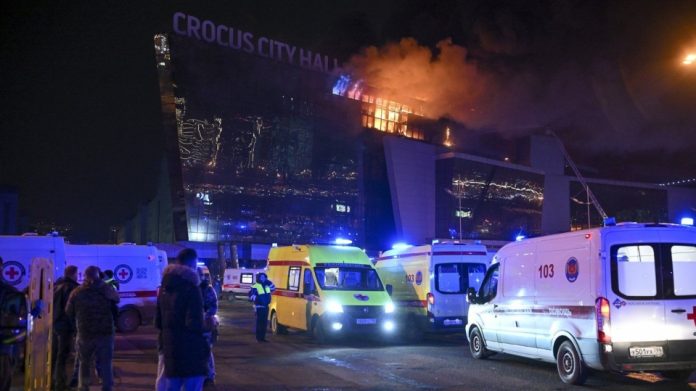Assailants stormed into a prominent concert hall in Moscow on Friday, unleashing a barrage of gunfire into the crowd, resulting in the deaths of over 60 individuals and causing injuries to more than 100 others. The brazen attack occurred just days after President Vladimir Putin secured his authority through a highly orchestrated electoral victory.
Claiming responsibility for the assault, the Islamic State group issued a statement on affiliated social media channels. A U.S. intelligence official disclosed to The Associated Press that intelligence agencies had learned of the group’s Afghan branch planning an attack in Moscow and shared this information with Russian authorities.
Details regarding the fate of the assailants following the raid, classified by state investigators as terrorism, remained unclear.
This attack, which left the concert hall engulfed in flames with its roof collapsing, marked the deadliest incident in Russia in years. It unfolded amidst the ongoing conflict in Ukraine, now entering its third year. Moscow Mayor Sergei Sobyanin described the raid as a “tremendous tragedy.”
According to the Kremlin, President Putin was promptly briefed after the assailants breached Crocus City Hall, a sizable venue on Moscow’s western outskirts capable of accommodating 6,200 people.
The assault unfolded during a performance by the Russian rock band Picnic. The Investigative Committee, the nation’s top criminal investigation agency, reported that over 60 fatalities had been recorded by early Saturday. Health authorities compiled a list of 145 injured individuals, with 115 of them requiring hospitalization, including five children.
Speculations arose regarding additional casualties possibly trapped by the ensuing fire sparked by the assailants’ explosives.
Footage depicted the concert hall ablaze, with a thick plume of smoke billowing into the night sky. The scene was illuminated by the flashing blue lights of numerous emergency vehicles, including fire trucks and ambulances, while helicopters doused the flames with water.
Reports indicated that several armed individuals clad in combat attire entered the concert hall, firing upon attendees.
Eyewitness Dave Primov described scenes of panic and chaos as the attack unfolded. “There were volleys of gunfire,” he recounted. “People began to panic, started to run and collided with each other. Some fell down and others trampled on them.”
Videos circulating on Russian media and messaging apps depicted armed men indiscriminately shooting at terrified individuals. Guards at the concert hall reportedly lacked firearms, potentially resulting in casualties at the onset of the assault.
In a statement via its Aamaq news agency, the Islamic State group claimed responsibility for targeting a large gathering of “Christians” in Krasnogorsk on Moscow’s outskirts, alleging casualties in the hundreds. However, the authenticity of this claim remained unverified.
Nevertheless, U.S. intelligence sources confirmed the Afghan branch of the Islamic State group’s assertion regarding the attack in Moscow. The U.S. official revealed that intelligence agencies had received information in recent weeks indicating the group’s plans, which were conveyed to Russian counterparts earlier in the month.
Aymenn Jawad al-Tamimi, an expert on the terrorist organization, interpreted the IS statement as part of its strategy to “strike wherever they can” in their global campaign against perceived adversaries.
Expressions of shock, outrage, and solidarity poured in from around the globe following the concert hall assault. Meanwhile, questions arose on Russian social media regarding the failure of authorities to preemptively identify and thwart the threat.
In response, Russian officials announced heightened security measures across Moscow’s transportation hubs and public spaces. Mayor Sobyanin canceled all mass gatherings, with cultural institutions closing their doors for the weekend. Similar security measures were implemented in other regions across Russia.
While the Kremlin refrained from assigning blame for the attack immediately, some Russian lawmakers swiftly pointed fingers at Ukraine, advocating for retaliatory actions. Preceding the attack, the Russian military launched a comprehensive strike on Ukraine’s power infrastructure, exacerbating tensions between the two nations.
Dmitry Medvedev, Russia’s Security Council deputy head, issued a stern warning, asserting that if Ukrainian involvement were proven, those responsible “must be tracked down and eliminated without mercy.”
Ukrainian officials promptly refuted any involvement, asserting their nation’s commitment to non-terroristic means of conflict resolution.
Statements of condemnation and sympathy emanated from the White House, with National Security Council spokesman John Kirby describing the imagery of the attack as “horrific” and “difficult to watch.”
The attack came in the wake of earlier warnings by the U.S. Embassy in Moscow, cautioning against crowded gatherings in light of extremist threats targeting the Russian capital. This advisory, echoed by several Western embassies, prompted the U.S. government to share intelligence with Russian authorities, as part of its “duty to warn” policy.
President Putin, following his re-election, dismissed these Western warnings as attempts to intimidate Russians, characterizing them as “open blackmail” intended to destabilize society.
The incident rekindled memories of Russia’s tumultuous history with terrorism, particularly notable are the deadly attacks in the early 2000s during the conflict with Chechen separatists.
In October 2002, militants seized a Moscow theater, leading to a tragic outcome when Russian special forces intervened. Two years later, a hostage crisis unfolded in Beslan, resulting in the loss of hundreds of lives, predominantly children.





